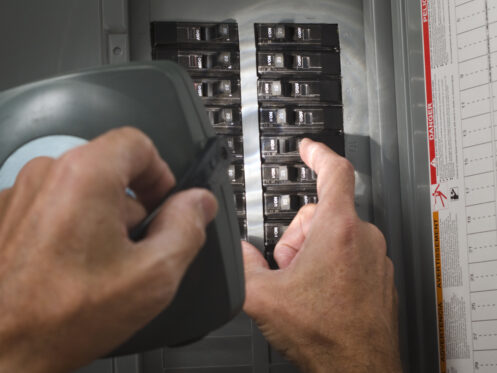Holiday plans focus on decorations, menus, and travel. What often gets missed is the one thing tying it all together: your home electrical system. As string lights, space heaters, and extra kitchen gadgets come out, your wiring carries more than its usual load. A safe holiday starts long before the first outlet gets plugged in.
That’s why Huft Home Services in Sacramento, CA helps you prep early so that the only sparks flying are in your fireplace. If you haven’t scheduled a pre-season electrical inspection yet, now is a smart time to lock it in.
Decorations Demand More Than You Think
Holiday decorations look simple from the outside, but they can place heavy demands on your wiring when combined on older circuits. A few strands of lights or a motorized yard display might seem harmless, but when outlets are already shared with other devices, it adds up. You might hear a faint buzz from a plug or notice a warm cover plate near the outlet. These early signals often go ignored in the rush to decorate.
What you don’t see is the heat building inside the wires or the stress on a breaker that may be nearing its trip threshold. If your outlets have scorch marks, if breakers trip when lights are plugged in, or if your cords feel hot, those are not seasonal quirks. See SMUD’s holiday lighting safety guidance on light strands, timers, and extension cords. They are symptoms of a system already working too hard. Testing your system before the lights go up is a smart way to prevent problems that don’t give second chances.
Kitchens Get No Break During the Holidays
Cooking around the holidays brings out appliances that usually sit in storage. You might plug in a countertop roaster, an electric carving knife, a coffee urn, or a slow cooker all at once. Then the microwave runs on top of that, and the fridge cycles in the background. The wiring behind your cabinets has to keep up with all of it. Outlets that are already shared on the same circuit can suddenly carry more current than they’re rated for.
When that happens, it’s not always obvious. A device may still work while the wires behind the wall overheat. Circuit breakers are designed to trip, but with moderate overloads, they may take time to respond. Older homes, in particular, may not have dedicated kitchen circuits for modern demands. If the insulation around those wires starts to fail, the risk isn’t just a tripped breaker. It’s a fire that starts in the wall before anyone smells smoke. That’s why electricians look behind the switches and receptacles, not just at what’s plugged in.
Guests Add Unexpected Electrical Load
When visitors stay over, your home quietly takes on more load. Bathrooms see more use, portable heaters get moved around, and bedrooms may get powered with extension cords to add lamps, chargers, or air mattresses with built-in pumps. None of this feels like a significant change, but it shifts the balance of your system. If outlets spark when a plug is inserted or if you hear a crackling sound from a light switch, that’s a warning to check for loose terminals or damaged wiring. Shared circuits between rooms can become overloaded during busy weekends.
Bathrooms with older GFCI outlets may not trip properly, especially if they haven’t been tested in years. Your guests might not notice anything wrong, but those subtle signs often point to wear inside the electrical box.
Outlet Damage Hides in Plain Sight
Outlets take a lot of abuse. Decorations get plugged in and unplugged repeatedly. Power strips get twisted to reach the right spot. Cords stretch around corners, and plugs sometimes hang half-in. Over time, the contacts inside your outlets loosen. When that happens, the plug doesn’t sit tightly. That gap creates resistance, which creates heat. You might notice a faint odor, or maybe the plug falls out easily.
These small signs add up. The plastic around the outlet can melt slowly and go unnoticed behind furniture. If a child or pet touches an unstable plug, the shock risk increases. Inspecting outlets before the season starts means finding these weak spots while they’re still easy to fix. Newer tamper-resistant outlets also help protect your family during busy seasons. Loose outlets and cracked faceplates may seem minor, but in a busy home, they’re often the first thing to go wrong when systems are stressed.
Older Panels Struggle to Keep Up
Electrical panels have a limit, and that limit gets tested during the holidays. If your panel is over 30 years old, it may not have the capacity for today’s appliances and technology. Even if it isn’t that old, some panels were made with outdated breakers that don’t trip reliably. You might not notice anything until you plug in a space heater, and lights flicker across the house. That flicker is your system struggling to distribute power.
Some breakers are designed to safely accept two wires, but most “double-tapped” connections are unsafe and can cause overheating. Inspecting your panel before the holidays gives you a chance to spot overheating, corrosion, or poor connections. If your panel cover is warm to the touch or if you hear buzzing from inside it, those are signs that you should not ignore. A licensed technician can read the panel load and let you know if a panel upgrade is needed before your system is pushed too far.
Space Heaters and Holiday Fire Risks
Space heaters fill in the gaps when certain rooms run colder than others, especially in older homes. During the holidays, they often get plugged into guest rooms, basements, or porches to keep company comfortable. What’s often missed is how much power they draw. Most space heaters use 1,500 watts, see PG&E’s heater safety advisory for California homes, which is about the limit of a typical 15-amp circuit. That means if anything else is plugged into that circuit, it may not take much to overheat the wires.
Extension cords and power strips make things worse by concentrating heat in small areas. If you’ve ever felt a cord get soft or warm while the heater runs, that’s a warning see CAL FIRE’s safe home heating tips. Fire departments list space heaters among the leading causes of winter home fires. Inspections help identify circuits that aren’t safe for heaters or overloaded strips.
Light Displays Can Overwhelm Outdoor Wiring
Outdoor lighting transforms a home during the holidays, but it can overload circuits that were never meant for that much use. If your outdoor outlets are on the same circuit as indoor lighting or garage tools, it doesn’t take long before the breaker trips. Not all outdoor outlets have working GFCI protection either. That can be dangerous if moisture builds up in plugs or light sockets.
When outlets are covered in old paint, cracked, or unsealed, water can enter and cause short circuits. You may not notice until the lights stop working, or worse, sparks fly when you plug them in. Even lights labeled as “low energy” can pull more than expected when combined. A pre-season check tests these outlets, confirms proper grounding, and verifies the wiring can handle the setup you plan to run.
Schedule Your System Check Today
The holiday season isn’t the time to second-guess whether your system can handle the extra load, hence the reason you must schedule a service call now. In addition to inspections, we also offer panel upgrades and outlet repairs if your home needs them. Schedule your inspection today with Huft Home Services and start the season with confidence.




